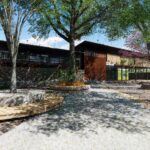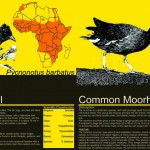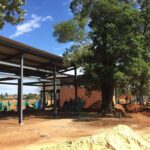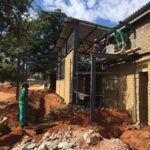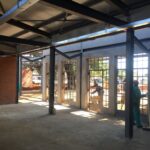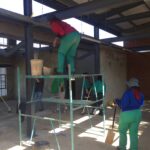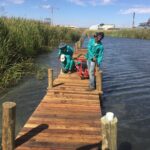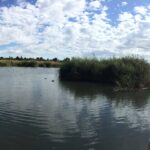Randfontein Bird Sanctuary & Environmental Education Centre
Integrating Sustainability with Community-Centered Design
The Randfontein Bird Sanctuary & Environmental Education Centre stands as a significant architectural contribution to the Helikon Park area in Randfontein. Designed by C+B Architects, the sanctuary blends seamlessly into its natural surroundings while emphasizing sustainable building practices and promoting environmental awareness. The project is a testament to our commitment to thoughtful, eco-friendly design solutions that serve both the environment and the local community.
Site and Design Overview
Located on Desert Street, the sanctuary spans a carefully preserved green space, offering visitors an opportunity to reconnect with nature. Central to the design is a walking trail, approximately 30 minutes in length, that weaves through the sanctuary’s natural habitats, including an unofficial bunny park adjacent to the walking path. This trail is strategically designed to offer immersive experiences, guiding visitors through various ecosystems while maintaining a minimal environmental footprint.
The sanctuary features two sustainably designed buildings at the main entrance. These structures serve as the administration offices and an environmental education center, built to complement the natural landscape. The buildings are equipped with rainwater harvesting systems, with Jojo tanks installed on-site to store water for irrigation purposes, reducing reliance on external water sources and promoting self-sufficiency.
Emphasis on Sustainable Construction
C+B Architects prioritized sustainability throughout the development of the Randfontein Bird Sanctuary. The structures are designed to maximize energy efficiency and minimize environmental impact. Locally sourced materials, including on-site manufactured bricks, were utilized to further reduce the carbon footprint associated with transportation and material production.
The use of local labor, particularly through the Community Work Project (CWP), played a key role in the construction phase. By employing and upskilling workers from the surrounding community, the project not only fostered economic growth but also provided valuable construction skills that workers can apply to future projects. This focus on community empowerment is a key element of our design ethos, ensuring that the sanctuary supports the local economy as well as the environment.
Function and Purpose
The Environmental Education Centre is central to the sanctuary’s mission. Equipped with modern facilities, it is designed to serve local schools and community groups, fostering environmental awareness and promoting sustainability. Educational programs will be hosted here, focusing on biodiversity conservation and the importance of environmental stewardship.
In addition, a fully operational café offers a welcoming space for visitors to relax and enjoy the surroundings. The café complements the sanctuary’s broader mission by encouraging visitors to spend more time in nature, fostering a deeper connection to the environment.
Community and Environmental Impact
The Randfontein Bird Sanctuary not only serves as a recreational area for local residents but also plays a crucial role in promoting environmental education and sustainability. Through its carefully designed spaces, the sanctuary fosters a relationship between visitors and the natural world, providing a unique opportunity for both passive and active engagement with the environment.
The project is also a model for sustainable urban development—balancing the needs of the local community with environmental preservation. The focus on low-impact construction techniques, water conservation, and local material sourcing aligns with C+B Architects’ commitment to innovative, forward-thinking design that respects the local context.
Key Project Features:
- Location: Desert Street, Helikon Park, Randfontein
- Sustainability: Rainwater harvesting, on-site Jojo tanks, on-site brick manufacturing, use of local labor
- Facilities: Walking trail, environmental education center, café
- Community Engagement: Local labor employment, skill development through the Community Work Project (CWP)


